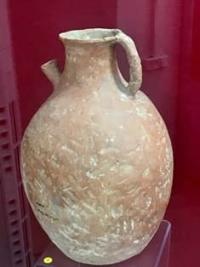Вы здесь
Ancient settlement Zhalpaktobe. Jikil town.

Photo tours across Zhambyl region.
"Small town", surrounded by a fortified wall, with a cathedral mosque in the market square and located at a distance of the "human voice"
Arab geographer and historian Masudi (Mas-udi Abulhasan Ali). "Muraujuz-Za-khab wa Ma dinuljauhar" ("The Book of Golden Meadows and Mines of Precious Stones").
Sacred places of Zhambyl region.
The town of Jikil (Chigil) is mentioned in the list of cities as a sedentary agricultural region and is described as “a small town at the distance of a human voice from Taraz: there is a wall around it, and it has a citadel. The Cathedral Mosque is on the market.
The town also existed in the XI century. and is mentioned by Mahmud of Kashgar. Djikil most likely corresponds to the settlement of Zhalpaktobe, located 5 kilometers from the settlement of Taraz. The ancient settlement Zhalpaktobe is a sub-rectangular hill with dimensions at the base of 90 - 95 meters and a height of 3 - 4 meters.
In the eastern part there was a citadel preserved as a hill 4.5 meters high and 30 meters in diameter. Around the hill, traces of a ditch 0.5 meters deep and 10 meters wide are still visible. The central entrance to the settlement was in the middle of the southern wall.
At present it looks like a hollow and is flanked on both sides by two rounded towers. Investigations in 1996 revealed a wall at a distance of 1 - 1.5 kilometers from the central ruins. Excavations on the territory of the settlement revealed the nature of the development at the level of the 6th-9th centuries, which was continuous: all the premises were attached to one another.
Inside living quarters, on the floor, open hearths are typical and along the walls - sufas. The walls are built of mud bricks and set on a cobblestone foundation. In the pantry-rooms, grain pits were arranged. The ceramics of the Zhalpaktobe settlement is represented by circles decorated with floral carved ornaments, cauldrons with arcuate and segmental handles, clay and alabaster round tables-dastarkhan, lamps.
The Turgesh coins found here allow dating the complex to the VIIth - IXth centuries. As for the upper building horizon, judging by the presence of fragments of glazed ceramics, the buildings of this layer belonged to the X - XII centuries.
Excavations made it possible to find out the nature of the fortification of the town.
The walls have survived to a height of 4 meters. At the base, their width was 5 meters, upward they narrowed. Lakh blocks (80 x 80 x 60 cm) were laid at the base of the walls; adobe bricks (35 x 25 cm) were laid on them. Round towers were located at the corners of the walls. The northern wall had a berm - a ledge 4 meters wide.
Authority:
K.M. Baypakov. “Medieval settlements on the Great Silk Road”. Almaty, "Gylym". 1998.
Photos by:
Alexander Petrov.







